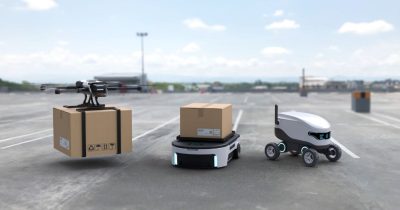Autonomous vehicles have helped transform the way logistics companies conduct their operations. Across the globe robotics companies are coming up with innovative ways to make the logistics and delivery process fast, seamless and accurate.
Let’s explore the advancements of autonomous vehicles for logistics and delivery.
What is the purpose of autonomous vehicles?
This modern technology exists to help improve traffic flow. Autonomous vehicles equipped with adaptive cruise control improve traffic management and reduce congestion through precise navigation.
Automated driving systems play a crucial role in enhancing traffic management and reducing congestion by utilizing advanced maps, sensors, and control systems.
On the environmental front, a self-driving vehicle enhances fuel efficiency of a fleet and reduces emissions. With route optimization, driving patterns and minimizing idling and aggressive driving – no more road rage!
Here’s a scenario: You are a delivery company that handles hundreds of deliveries across the country. Your business is picking up exponentially, and demanding customers are not happy that your traditional trucks are often delayed. You also have a particular customer who needs medication for an acute illness.
What’s your solution? Maybe a drone.
Drones are a self driving technology genius
Picture this: You are walking in your suburb and notice a flying object. No it’s not some unidentified flying object from out of space, but a drone whizzing through the air. The drone is in flight to deliver groceries to a retail chain’s customer.
Traditional order and delivery is being turned on its head, by the positive advancements drones bring: Here’s why drones are a firm choice for logistics businesses.
Amazon introduced a 60-minute medicine drone delivery service with its MK30 drone. Now with Amazon drone delivery in Arizona, it also provides a win for the environment.
Key features of drones
- Speed: Drones allow logistics companies to bypass peak traffic, especially in urban areas by optimizing delivery routes.
- Cost savings: They can cut fuel expenses. A company will also save on labor expenses because no ground vehicle is in use for a drop off.
- Accessibility: Drones can deliver to remote locations, including islands or disaster affected areas.
- Delivery vehicles: Scanning orders onto delivery vehicles updates the status for both sender and recipient, ensuring transparency and efficiency in the delivery process.
- Tracking: This modern technology gives customers real-time tracking which gives customers peace of mind.
But it’s not just the delivery aspect that makes drones a firm favorite, but management of logistics operations.
On, a global sportswear brand, and Verity, an AI and robotics company, are working together to improve warehouse operations and inventory management.
How are drones used in warehouses?
- Inventory management: Drones are used to conduct regular inventory checks by scanning barcodes or radio frequency identification tags, providing real-time data on stock levels and locations.
- Shelf scanning: Drones can fly through aisles to scan and monitor shelves, ensuring items are correctly placed and easily accessible.
- Stocktaking: Drones automate the stocktaking process, reducing the time and labor required for manual counts.
Need a delivery robot?
Let’s face it, robots are super cool. Not only is this a modern marvel, but it’s trending! Companies like Uber Eats have taken on the technology to make deliveries quick. You can now have your fast food craving delivered to your door with a robot.
There is an upside to having a fast food company that uses robots. Robots provide reliable service, unaffected by human factors such as fatigue or availability.
A customer could also order at any hour. Imagine a customer orders a pizza at 2am. Once the order is placed, the delivery company dispatches the robot to make a quick drop-off. Craving satisfied. The company also doesn’t have to worry about additional labor costs.
Why would a customer want a robot to deliver their order? Pure novelty perhaps.
But there’s another great reason: Customers can track their orders in real-time and receive notifications upon arrival. This level of service enhances customer satisfaction and loyalty.
Autonomous vehicles have made it possible for logistics and delivery companies to go where no normal vehicle has gone before – remote areas hard to access. Delivering to a mountainous region is no problem.
Driverless vehicles in logistics
One example of a company blazing a trail in automated driving is Kodiak.
Founded in 2018 by self-driving industry veterans, the company’s mission is to solve trucking industry challenges.
CEO Don Burnette says since its inception, the company has focused on developing an autonomous product that global business leaders integrate into their business operations. Automated vehicles play a crucial role in logistics by enhancing efficiency and reducing operational costs.
The company partnered with shipping giant Maersk on a driverless truck project.
How are advancements in autonomous trucking technology reshaping the logistics industry and improving operational efficiencies?
“As the first autonomous trucking company to establish this new commercial lane between Houston and Oklahoma City, we are demonstrating our team’s ability to introduce new lanes and bring new efficiencies to the entire logistics industry,” says Burnette.
Here’s some features of the Kodiak driverless truck:
- Every tenth of a second, the truck evaluates the performance of more than 1,000 safety-critical processes and components in the self-driving stack and the underlying truck platform.
- The trucks learn in parallel, with system upgrades shared with the entire fleet simultaneously.
- Trucks are not subject to environmental distractions.
How can automated driving systems help in logistics?
Lower transportation costs
Reduce expenses related to vehicle ownership, including insurance, maintenance, and fuel, particularly for shared autonomous vehicles. Additionally, connected and automated vehicles can further lower costs by optimizing routes and reducing idle times.
Flexible solutions
Offer flexible and scalable transportation solutions that can adapt to changing needs and urban growth.
Reduced driver stress
Alleviate the burden of driving, particularly in heavy traffic or long commutes, allowing passengers to use their time more productively.
Driver assistance
Advanced driver assistance systems (ADAS) enhance safety and efficiency in logistics by providing features such as lane-keeping, cruise control, and emergency braking. These systems reduce the likelihood of accidents and improve overall vehicle performance.
Autonomous vehicle market
Grand View Research reports the autonomous vehicle market is expected to achieve excellent growth in the next six years.
Automotive engineers play a crucial role in the development of autonomous vehicles, defining the stages of automation as per the classification system developed by the Society of Automotive Engineers (SAE) and adopted by organizations such as the U.S. National Highway Traffic Safety Administration (NHTSA).
The advancements in self-driving technology are predicted to significantly impact road safety, land-use patterns, and mobility, with numerous historical and current examples of self-driving car developments and services.
What’s contribution to market growth?
“Advancements in AI, connectivity, and sensor capabilities are crucial for the market’s growth, enabling vehicles to make more informed decisions and navigate complex environments efficiently,” reads the report.
The operational design domain (ODD) plays a significant role in the development of autonomous vehicles, defining the specific operating conditions such as environmental, geographical, and traffic factors.
The report adds that these technological strides enhance vehicle safety and reliability and also expand the scope of autonomous applications across industries, from logistics and transportation to ridesharing and delivery services.
“The cost-efficiency brought about by these advancements makes autonomous solutions more appealing to businesses seeking innovative and competitive edge offerings, ultimately propelling the market’s expansion and adoption.”
About the author
Sharl is a qualified journalist. He has over 10 years’ experience in the media industry, including positions as an editor of a magazine and Business Editor of a daily newspaper. Sharl also has experience in logistics specifically operations, where he worked with global food aid organisations distributing food into Africa. Sharl enjoys writing business stories and human interest pieces.











